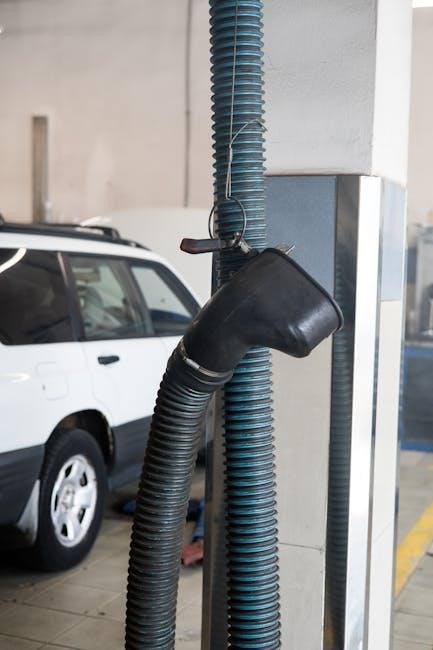The check engine light on Scag mowers indicates potential issues, flashing fault codes to help diagnose problems like sensor malfunctions or mechanical failures. Understanding these codes is essential for timely repairs and maintaining equipment performance. Referencing Scag PDF guides or authorized dealers can provide detailed insights and solutions to resolve the issues effectively.

Common Causes of the Check Engine Light
Mechanical issues, faulty sensors, and software glitches often trigger the check engine light. Maintenance oversights, such as loose gas caps, can also activate the warning system unexpectedly.
Mechanical Issues
Mechanical issues are a primary cause of the check engine light on Scag mowers. Problems such as faulty oxygen sensors, worn spark plugs, or damaged ignition coils can trigger the light. Additionally, issues with the engine’s cylinders, pistons, or valves may also activate the warning system. These mechanical faults often lead to misfires or irregular engine performance, which the ECU detects and signals through the check engine light. Regular maintenance, such as replacing spark plugs and inspecting ignition components, can help prevent these issues. If ignored, mechanical problems can escalate, leading to more costly repairs. Addressing these issues promptly ensures optimal mower performance and longevity.
Faulty Sensors
Faulty sensors are a common trigger for the check engine light on Scag mowers. Sensors such as the oxygen sensor, coolant temperature sensor, or mass airflow sensor play a crucial role in monitoring engine performance. When these sensors malfunction, they send incorrect data to the ECU, which then illuminates the warning light. For example, a faulty oxygen sensor can cause improper air-fuel mixture calculations, while a malfunctioning coolant temperature sensor may lead to incorrect engine timing. If the ECU detects irregular readings, it logs a specific fault code and activates the check engine light. Identifying and replacing the faulty sensor promptly is essential to restore proper engine function and prevent further damage. Regular sensor maintenance can help avoid such issues.
Software Glitches
Software glitches in the engine control unit (ECU) can trigger the check engine light on Scag mowers. These issues may arise from outdated or corrupted software, leading to improper communication between sensors and the ECU. For instance, a known problem with the Kohler ECU has been reported, where the system incorrectly logs fault codes. Such glitches can cause the light to illuminate even when no mechanical issue exists. Resetting the system or updating the software often resolves these problems. Users can try turning the ignition key on and off to see if the light resets. If the issue persists, consulting the Scag PDF guide or contacting an authorized dealer is recommended for a proper diagnosis and solution. Regular software updates can help prevent these glitches.
Maintenance Oversights
Maintenance oversights are a common cause of the check engine light on Scag mowers. Issues like loose connections, dirty air filters, or incorrect oil levels can trigger the light. For example, a loose battery terminal or faulty spark plug connection may cause the system to malfunction. Additionally, neglecting to clean or replace the air filter can lead to poor engine performance, activating the check engine light. Regular maintenance, such as checking fluid levels and ensuring all connections are secure, can help prevent these issues. Users should also refer to the Scag PDF guide for recommended maintenance schedules to avoid unnecessary complications. Addressing these oversights promptly can resolve the light and ensure optimal mower performance. Proper upkeep is essential for long-term reliability.
How to Retrieve Check Engine Light Codes
Retrieving check engine light codes on Scag mowers can be done using diagnostic tools or by following specific ignition key cycles. Referencing Scag PDF guides provides detailed steps for code retrieval, ensuring accurate diagnosis and repair. Built-in methods or scan tools simplify the process, helping users identify issues efficiently.
Using Scag PDF Guides
Scag PDF guides are a valuable resource for understanding and retrieving check engine light codes. These guides provide detailed instructions on how to interpret the blinking light sequences, which correspond to specific fault codes. By referencing the PDF manuals, users can identify issues such as sensor malfunctions or mechanical problems. The guides often include step-by-step procedures, such as turning the ignition key on and off to activate the diagnostic mode. Additionally, Scag PDF guides list common trouble codes, their meanings, and recommended repairs. This makes it easier for users to diagnose and address problems independently. Regularly consulting these guides ensures that equipment is maintained properly and issues are resolved promptly, preventing further damage. They are available online or through authorized Scag dealers, making them accessible for all users.
Built-in Diagnostic Methods
Scag mowers often feature built-in diagnostic methods to retrieve check engine light codes. By turning the ignition key on and off in a specific sequence, the check engine light will flash a series of codes. Each flash corresponds to a particular issue, such as a faulty sensor or mechanical problem. Users can count the number of blinks to identify the code. For example, three blinks followed by two pauses and then two blinks may indicate a specific sensor malfunction. This method is straightforward and requires no additional tools. However, interpreting the codes accurately is crucial, and referring to Scag PDF guides or authorized dealers ensures correct diagnosis. This built-in feature allows users to quickly identify issues, enabling timely repairs and preventing further damage to the equipment. Regular use of this method helps maintain optimal performance and longevity of the mower.
Utilizing Scan Tools
For advanced diagnosis, utilizing scan tools is an effective method to retrieve check engine light codes on Scag mowers. These tools connect to the engine’s ECU, providing detailed fault codes and real-time data. Scan tools offer precise code definitions, eliminating guesswork. They can also clear codes after repairs and perform system tests. While built-in methods are handy, scan tools are more comprehensive, especially for complex issues. They are widely available, from basic OBD-II readers to specialized software for Scag equipment. Dealers often recommend these tools for accurate troubleshooting. Using scan tools ensures efficient repairs, reducing downtime and costs. Regular use helps maintain equipment health and prevents recurring problems. This approach is ideal for both DIY enthusiasts and professionals seeking detailed insights. Scan tools are a valuable asset for anyone managing Scag mower maintenance and repairs.

Understanding Scag Check Engine Light Codes
Scag check engine light codes indicate specific issues, such as sensor malfunctions or mechanical faults. These codes, often found in Scag PDF guides, help diagnose and repair problems efficiently.
Code Structure and Format
Scag check engine light codes follow a specific structure to help identify issues. Typically, codes consist of a combination of letters and numbers, such as “P0171” or “C1234.” The first character often indicates the system affected, like “P” for powertrain or “C” for chassis. The remaining digits or letters provide more detailed information about the specific fault. For example, “P0171” might indicate a system too lean, while “C1234” could relate to a sensor malfunction. Referencing Scag’s official PDF guides or diagnostic tools is essential to decode these sequences accurately. Understanding the format ensures proper diagnosis and repair, as each code points to a specific problem area within the engine or related systems.
Common Code Examples
Common Scag check engine light codes include “P0171” for a system too lean, “P0300” for a random cylinder misfire, and “C1234” for specific sensor malfunctions. Codes like “0131” may indicate issues with oxygen sensor performance, while “0118” could point to problems with the engine’s cooling system. These codes often correspond to common problems such as faulty sensors, ignition coil failures, or fuel system imbalances. For example, a blinking light pattern of three short flashes followed by one long flash might indicate a specific cylinder misfire. Understanding these examples helps users identify the root cause quickly. Always consult the official Scag PDF guide or a diagnostic tool for accurate code interpretation and repair guidance.
Manufacturer-Specific Codes
Scag equipment may display manufacturer-specific codes that differ from standard OBD-II codes. Codes like “C1234” or “P0171” are tailored to Scag systems, often indicating issues unique to their machinery. For example, “C1234” might relate to a specific sensor malfunction, while “P0171” could signal a lean fuel mixture. These codes are designed to help technicians pinpoint issues quickly. Manufacturer-specific codes require referencing Scag’s official PDF guides or diagnostic tools for accurate interpretation. For instance, “0131” might indicate an oxygen sensor issue, while “0118” could point to a cooling system problem. Always consult Scag’s resources or an authorized dealer to understand and address these codes effectively, ensuring proper repairs and maintaining equipment performance.
Preventive Maintenance Tips
Regular maintenance is key to preventing the check engine light from illuminating. Ensure air filters, oil, and spark plugs are checked and replaced as recommended in Scag PDF guides. Keep the mower deck clean and properly aligned to avoid sensor interference. Monitor fuel quality and ensure the tank is vented correctly to prevent pressure issues.Inspect belts and hoses for wear, and address any mechanical issues promptly. Proper software updates and calibration can also prevent glitches. Referencing Scag’s maintenance schedules and troubleshooting guides helps identify potential problems early, reducing downtime and repair costs. Consistent upkeep ensures optimal performance and minimizes the risk of fault codes appearing unexpectedly.

Resources for Scag Engine Light Codes
Scag provides comprehensive resources to help interpret and address check engine light codes. The official Scag PDF guides offer detailed code explanations, diagnostic procedures, and repair instructions. Authorized Scag dealers are equipped with specialized tools and knowledge to accurately interpret fault codes and recommend solutions. Online forums and communities often discuss common issues and share experiences with specific codes, such as 0131 or 0118. Additionally, YouTube tutorials and repair videos demonstrate how to read codes, identify problems, and perform repairs. These resources empower users to diagnose and resolve issues efficiently, ensuring their equipment runs smoothly and reliably.

DIY vs. Professional Repair
Addressing check engine light issues on Scag equipment can be approached through DIY methods or professional repair. DIY repairs are cost-effective for minor issues, such as replacing faulty sensors or updating software, using Scag PDF guides for reference. However, complex problems like engine mechanical failures or advanced sensor malfunctions often require specialized tools and expertise, making professional repair the safer choice. Authorized Scag dealers can quickly diagnose codes like 0131 or 0118 and perform precise repairs. While DIY can save money, improper fixes may lead to further damage. Balancing cost, convenience, and expertise is key to resolving issues effectively and ensuring optimal equipment performance.

Cost Considerations and Estimates
Addressing check engine light issues on Scag equipment requires evaluating repair costs. Minor issues, like replacing faulty sensors or updating software, may cost between $50 to $200. However, complex problems, such as engine mechanical failures or advanced sensor malfunctions, can range from $500 to $2,000 or more. DIY repairs using Scag PDF guides can save money but may not always be feasible for intricate issues. Professional repairs by authorized dealers ensure accuracy but come at a higher cost. Factors like labor fees, parts availability, and the severity of the fault code (e.g., 0131 or 0118) influence estimates. Balancing immediate repair costs with long-term equipment maintenance is crucial for avoiding further damage and ensuring optimal performance.

Resetting the Check Engine Light
Resetting the check engine light on your Scag mower can be done through several methods. The most common approach is to use a scan tool compatible with Scag equipment, which allows you to clear the stored fault codes. Alternatively, disconnecting the battery for a few minutes can sometimes reset the system, though this may not clear all codes. Additionally, some users have reported success by turning the ignition key on and off multiple times or pressing specific buttons on the control panel. It’s important to ensure that the underlying issue is resolved before resetting the light to prevent it from reappearing. Always refer to your Scag PDF guide or consult an authorized dealer for precise instructions tailored to your mower model.
Advanced Troubleshooting Techniques
Advanced troubleshooting for Scag check engine light codes involves using specialized tools and methods to identify and resolve complex issues. Utilizing a high-quality scan tool with live data capabilities can help pinpoint faulty sensors or system malfunctions. Additionally, performing function tests on components like oxygen sensors, ignition coils, and fuel injectors can reveal underlying problems. Some users have reported success with manual code retrieval by blinking patterns, while others rely on Scag-specific diagnostic software. It’s crucial to consult detailed repair manuals or authorized dealers for accurate interpretations and repairs. Advanced techniques ensure that the root cause of the issue is addressed, preventing recurring problems and maintaining optimal equipment performance. Always prioritize thorough diagnostics to avoid unnecessary repairs.



